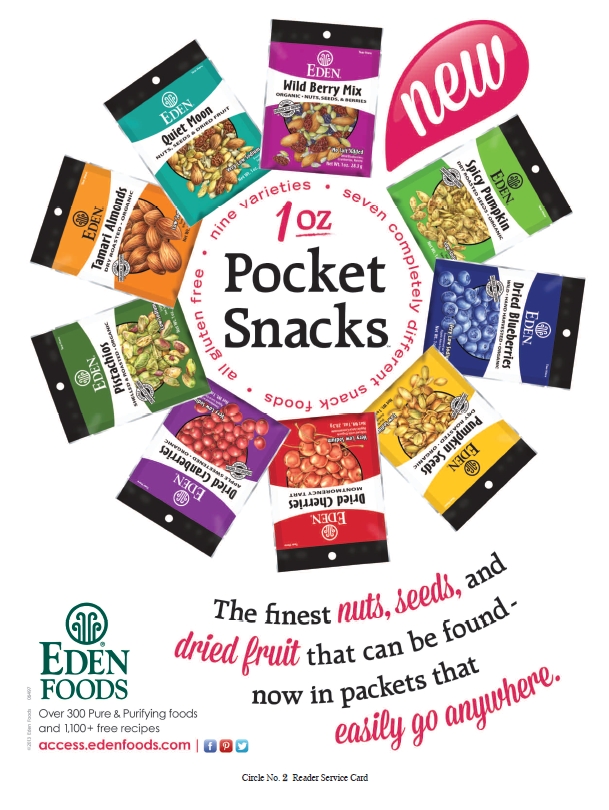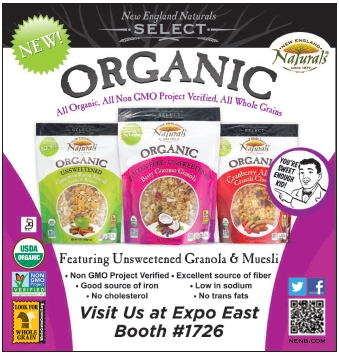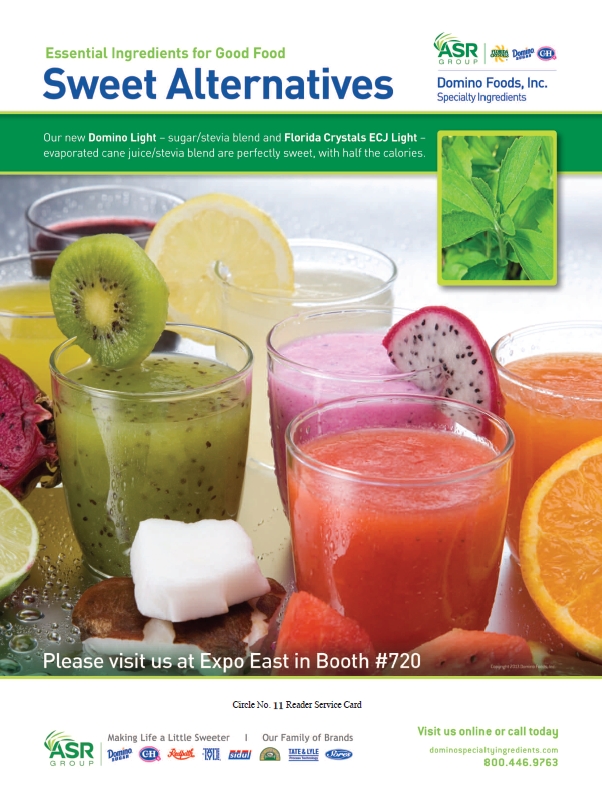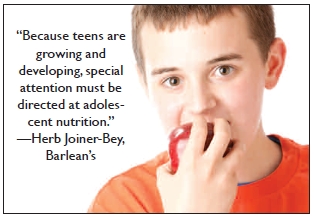A child’s school-age years are a special time, and not just because she/he moves from taking stroller rides to pedaling without training wheels to begging for your car keys! From ages four through 13, a child goes through a period of immense growth and development that’s topped off during the teen years.
Your store can help parents make sure their kids are getting everything from supplements to skincare to healthy foods and drinks to support this important growth period.
Don’t Miss Out
Several must-have nutrients support a child’s growth and development. Most appear in a high-quality children’s/teens’ multivitamin, and can be found in a nutritious diet:
• Iron helps to build muscle and make hemoglobin, which carries oxygen to red blood cells. Without enough iron, the body can’t make enough red blood cells—which means organs aren’t getting the oxygen they require. Adolescent girls are more at risk than boys for iron-deficiency anemia due to iron loss during menstruation.
• B-vitamins are also helpful for red blood cell formation. They promote healthy energy levels, metabolism and circulation.
• Vitamin A is needed for healthy eyes, skin and  tissue.
tissue.
• Vitamin C is well known for immune support, and is also needed for healthy muscles, tissues, gums and skin.
• Vitamin D is commonly deficient in children (and adults) and supports immune and heart health. It is vital for building healthy bones thanks to its ability to help metabolize calcium. Calcium, too, is a must for children since the bone mass a young person builds may affect his/her bone health down the road. Children four to eight years old should get 1,000 mg daily, while those nine to 18 years old should get 1,300 mg daily.
• Vitamin E protects cells and tissues, and supports red blood cells.
• Vitamin K2 helps the body better process calcium so as to build healthy bones. “Young bones are highly active and osteocalcin levels are eight to 10 times higher compared to adult bones, hence the requirement of vitamin K is also higher,” according to information provided by NattoPharma. “Population-based studies and clinical trials have tightly linked better K vitamin status in children (meaning higher levels of vitamin K2 found in blood serum) to the creation of strong and healthy bones.” Since many children are deficient in K2, the company recommends supplementation.
Other key components a child’s/teen’s diet should include are fiber, protein and omegas.
The Institute of Medicine says that kids should have 14 grams of fiber for every 1,000 calories of food they take in each day for proper digestion and for heart health. This benchmark is often missed, says Gillian Grefé, director of communications for Little Duck Organics, Brooklyn, NY: “Two common nutritional issues that kids are faced with today include eating too many products with added sugar and not getting enough fiber.” She says her company recently launched a sugar-free ancient grain-based baby cereal to help fill those needs.
Meanwhile, protein should make-up 10–20% of a child’s diet. That’s about 28 grams per day for a seven to 10 year old, which can be challenging for kids who don’t eat meat or dairy. In addition to building, maintaining and replacing the body’s tissues, organs and muscles, protein helps prevent blood sugar spikes, which increase hyperactivity. As for getting enough protein throughout the day, material from Boulder, CO-based Justin’s suggests that a challenge in this area is portability. The company says, “It has been increasingly difficult to find healthy and convenient snacks that will not only appeal to kids, but also provide the brain power to get them through the school day…When it comes to snack time, junk food (especially chocolate) has become the go-to fuel for kids of all ages.” To combat this, the firm makes nut butters in squeeze packs that have six to eight grams of protein and heart-healthy monounsaturated fats. They also offer a portion-controlled peanut butter cup and all-natural candy bars “that have 25% less sugar, 50% more protein and 100% more fiber than a Snickers.”
 Omegas are integral for many aspects of a child’s development from eye to brain health. The latter has implications for attention, learning and behavior, areas that are a struggle for many children and teens, as we’ll see a little later.
Omegas are integral for many aspects of a child’s development from eye to brain health. The latter has implications for attention, learning and behavior, areas that are a struggle for many children and teens, as we’ll see a little later.
Moving on up. While a typical 15-year-old may want to be treated as an adult, tell parents to resist from a nutritional standpoint. At the same time, they’re certainly not kids anymore. According to Alan Assael, director of sales at Advanced Nutrition by Zahler, Inc., Brooklyn, NY, one’s age and developmental stage is tied to their nutritional requirements. “Infants, toddlers, older children, adults and the elderly all have different nutritional needs,” he believes. “The most effective way of determining their needs is to discuss it with their healthcare provider.”
Craig Klein, M.S., L.N. , C.N.S., national educator at Michael’s Naturopathic Programs, San Antonio, TX, says, “A teenager’s needs are greater than that of a tween in that the need for many nutrients has increased. This is due in part to overall physical growth and to the developing reproductive system.”
He adds that a full-grown adult generally has different needs than those of teens. “There are variations that occur,” says Klein. “Generally speaking, a teen should take a teen-specific multi.”
One area that teens shouldn’t neglect, says Herb Joiner-Bey, scientific advisor to Barlean’s, Ferndale, WA, is bone health. “Bone growth requires a wide range of nutrients beyond mere calcium—magnesium, manganese, boron, strontium, silicon, folic acid, zinc, etc.,” he says, adding that a teen’s diet should include plenty of whole organic vegetables, fruits, nuts and seeds to cover these requirements.
For teens that aren’t getting enough, he suggests green food supplements as “an excellent source of these micro-nutrients.”
Another facet of teen’s nutrition comes from Maurizio Diamante, Ph.D., scientific  director at Erba Vita USA, LLC, New York, NY. He explains that menstrual-support dietary supplements may benefit young women to alleviate the discomfort of their monthly cycles. He feels that flax seed, raspberry, white willow and grape extract are especially useful for this purpose.
director at Erba Vita USA, LLC, New York, NY. He explains that menstrual-support dietary supplements may benefit young women to alleviate the discomfort of their monthly cycles. He feels that flax seed, raspberry, white willow and grape extract are especially useful for this purpose.
Taste test. When stocking your kids’ supplements, it should go without saying that the delivery method is key for determining whether a child will actually stick to taking it. States Hallie Rich, founder and president of Rich Vitamins LLC, New York, NY, “No matter how potent a supplement, if it doesn’t taste good and isn’t appealing to take daily, it will just collect dust on the shelf.”
This means getting samples of kids’ liquid, chewable and gummy supplements, and testing them out. Rich’s company specializes in tasty, quick-dissolving crystals (think Pixy Stix, but healthy), which not only deliver taste appeal, but also convenience, ease of administration and potency. “The quick-dissolving crystals allowed us the flexibility to incorporate all of these attributes,” she explains, noting that this format either can be poured in the mouth or mixed into yogurts, smoothies, shakes or puddings. With this method, “children can be passive or active participants in taking their daily multi,” she feels.
To circle back to an earlier point made by Joiner-Bey, just be sure your supplement buyers go over the label with a fine-tooth comb for sugar or artificial sweeteners, flavors, preservatives or colors. He states, “There’s no need to take in the bad with the good!”
For this reason, Diamante’s company avoids sucrose. “We use organic unrefined manioc syrup obtained by an enzymatic process of natural starch present in cassava,” he states.
Are You Listening?
No child has a perfect attention span. Minds wander, the fidgeting starts and before you know it, quiet time is now a game of Catch the Kid! While this is normal, 9.5% of kids ages four to 17 have attention deficit hyperactivity disorder (ADHD). That’s 5.4 million children as of 2007 (1).
Here’s an even more startling statistic: Nearly two-thirds of children diagnosed with this condition take prescription drugs to treat it (1). Children ages 11–17 are more likely to take medication than younger age groups, and boys are three times more likely than girls to be medicated (1).
This decision, of course, is for each parent (and their physicians) to make. But more and more want to know about what they can do to help their children from a nutritional standpoint—and this time, there’s lots of good news.
Stop it! Step one, according to Joiner-Bey, is to stop giving children anything that triggers distraction and hyperactivity like artificial colors and flavors, refined sugar and flour products. Some research indicates food colorings (like sodium benzoate, FD&C Yellow Nos. 5 and 6, D&C Yellow No. 10 and FD&C Red No. 40) and preservatives increase hyperactive behavior in some children, though one can’t say for certain they cause hyperactivity and ADHD (2).
“Ensure that teens eat foods rich in flavonoids, which help to restore the blood-brain barrier, thereby protecting brain cells from exposure to toxins from colon bacteria, as well as food additives,” Joiner-Bey states. “Flavonoid-rich foods include berries, greens and grape seed extract.”
 In Kids’ Health: A Doctor’s Guide for Parents, Carolyn Dean, M.D., N.D., speaks of a study done with 182 pediatric patients with behavioral and learning problems. The children were put on an elimination diet, which prohibited food coloring, food additives, sugar, wheat, eggs, milk, corn, chocolate and citrus. When a child’s symptoms improved after being on the diet, she/he was challenged with one eliminated food per day. Overall, it was determined in 128 children that at least one dietary ingredient was linked to his/her condition.
In Kids’ Health: A Doctor’s Guide for Parents, Carolyn Dean, M.D., N.D., speaks of a study done with 182 pediatric patients with behavioral and learning problems. The children were put on an elimination diet, which prohibited food coloring, food additives, sugar, wheat, eggs, milk, corn, chocolate and citrus. When a child’s symptoms improved after being on the diet, she/he was challenged with one eliminated food per day. Overall, it was determined in 128 children that at least one dietary ingredient was linked to his/her condition.
In a separate seven-year study referenced by Dean, children in 800 New York schools were given meals without large amounts of sucrose and gradually eliminated artificial flavors/colors as well as some preservatives. According to Dean, “There was a 15.7 percent gain (from 39.2 to 55 percent) in learning ability compared with other schools during the years in which these food changes were introduced. Schoenthaler also noted that out of the 124,000 children who were unable to learn grammar and mathematics at the start of the study, 75,000 were able to perform these basic tasks after dietary changes alone.”
MAGnificent. Magnesium deficiencies are linked with developmental/neurological problems and even emotional and mental stress. The mineral (in balance with calcium) supports a healthy nervous system and may help alleviate anxiety and stress in some individuals. Given its ability to calm, it’s interesting to note some findings from a classic study on the matter (3). Some 116 children with ADHD participated, including 68 with other coexisting disorders that affect behavior. Magnesium deficiency was found in 95% of the children.
B calm. According to Dean, “The B vitamins are important as cofactors for thousands of metabolic functions in the body, including the complex functioning of the brain. They also help control mood swings at puberty.”
Klein explains that B-complex vitamins as well as minerals and amino acids help to make neurotransmitters like serotonin, dopamine, acetylcholine and others. Among other jobs, serotonin is key for a healthy mood, while dopamine may help with learning and focus. In fact, a major ADHD drug (Ritalin) works by increasing dopamine levels, which may enhance task-specific signaling, improve attention and decrease distractibility—all associated with the disorder (4).
According to Dean, “Methylated (partially metabolized) forms of the B vitamins are very important in autism and ADHD to overcome specific enzyme blocks.”
In a two-month study (5) of 40 magnesium-deficient children with ADHD, supplementation with magnesium (6 mg/kg/d) and vitamin B6 (0.6 mg/kg/d) helped improve hyperactivity, aggression and lack of attention at school in nearly all cases. When the supplementation stopped, the symptoms ramped up again. Stated the researchers, “This study brings additional information about the therapeutic role of a magnesium-B6 regimen in children with ADHD symptoms.”
“Considering the often-inconsistent diet of children and teens,” Klein states, “supplementation can be a good option.”
Focus on omegas. Omega-3s are integral building-blocks for brain cells and key for making hormones in the brain that regulate the growth, development and behavior of neurons, says Joiner-Bey. Thus, it’s not a big leap of logic to understand that omegas DHA, EPA and ALA support brain health (including learning and behavior) in kids.
Fish oil is well researched in this area, and Jolie Root, nutritionist for Carlson  Laboratories, Arlington Heights, IL, gives us two examples of studies into this link. She states, “Dietary supplementation with fish oils (providing EPA and DHA) appears to alleviate ADHD related symptoms in at least some children, and one study of developmental coordination disorder children also found benefits for academic achievement.” In the Oxford-Durham study of children with developmental coordination disorder, significant improvements were found over the placebo in reading, spelling and behavior after three months (6). Another study also found DHA supplementation helped improve reading and behavior (7).
Laboratories, Arlington Heights, IL, gives us two examples of studies into this link. She states, “Dietary supplementation with fish oils (providing EPA and DHA) appears to alleviate ADHD related symptoms in at least some children, and one study of developmental coordination disorder children also found benefits for academic achievement.” In the Oxford-Durham study of children with developmental coordination disorder, significant improvements were found over the placebo in reading, spelling and behavior after three months (6). Another study also found DHA supplementation helped improve reading and behavior (7).
While the marine omegas get a lot of attention for brain health, Joiner-Bey tells us omega-3s from flaxseed oil may help those with ADHD, as well as improve learning ability in children and teens. In a study of children with ADHD (8), ALA-rich flax oil and antioxidants like vitamin C were given to participants. After supplementation, their levels of RBC membrane fatty acids were significantly higher than at baseline and hyperactivity symptoms improved. Plus, “Adding sources of GLA, such as borage oil or evening primrose oil, can reinforce the benefits of omega-3s in ADHD,” he believes.
In addition to flax, some companies like Hero Nutritionals have brought to market chia-based supplements that are rich in ALA and other nutrients.
Sum it up. Dean offers her advice for what children should take in a multi, whether or not behavior or attention are issues:
• Magnesium: 200 mg per day
• Calcium in balance with magnesium: 200 mg per day
• Zinc: 2–5 mg per day
• Essential fatty acids EPA and DHA: 150–200 mg per day of each
• B vitamins
• Vitamin C: 200 mg per day
• Vitamins A, D and E, as well as trace minerals
• Non-chewable, liquid form
• Non-sucrose sweeteners
The bottom line is to make sure kids have a great foundation for good health. States Diamante, “Certainly, maintaining health and well-being is essential to doing well in school and life. Kids can’t pay attention and focus if they are not well enough to attend school.”
 For this reason, he believes high-quality natural cold/flu products should be used when a child is under the weather. His firm likes natural, plant-based, non-GMO ingredients, especially bee-byproducts like propolis. He explains, “Propolis is an immunostilumant derived from beehives (it’s the resinous mixture that bees collect from botanical sources and use as a sealant in their hives) shown to benefit the immune system and also to gently soothe the throat and oral mucosa.
For this reason, he believes high-quality natural cold/flu products should be used when a child is under the weather. His firm likes natural, plant-based, non-GMO ingredients, especially bee-byproducts like propolis. He explains, “Propolis is an immunostilumant derived from beehives (it’s the resinous mixture that bees collect from botanical sources and use as a sealant in their hives) shown to benefit the immune system and also to gently soothe the throat and oral mucosa.
Powering Up
Some reports estimate energy drinks are consumed by 30–50% of all U.S. adolescents and young adults (9); of the 5,448 caffeine overdoses recorded in 2007 in this country, nearly half occurred in those younger than 19 (9). News reports have linked energy drinks with health issues in kids and teens; adults may experience increased heart rates and blood pressure, and the effects could be even more pronounced in adolescents. Despite this, energy drink consumption rose 16% from 2003 to 2008.
Meanwhile, sports drink consumption is increasing right alongside this market. Traditional sports drinks may contain up to 19 grams of added sugar, 200 mg of sodium and 80 calories per 8-ounce serving (10). According to the 2010 National Youth Physical Activity and Nutrition Study, 16.1% of high school students had at least one serving of a sports drink during the seven days before the survey; 9.2% had two or more servings per day. Teens tended to consume these drinks in lieu of soda to quench thirst, increase energy and boost sports performance (10).
But these drinks aren’t the best path to achieve these goals, many believe. In fact, they could be unintentionally putting roadblocks in the way. “Teens are burdening themselves with foods laden with sugar, which eventually depresses blood sugar levels, leading to fatigue,” says Joiner-Bey. Instead, he recommends pure water for hydration, or naturally flavored greens drinks (which can be mixed with water or club soda) and vegetable juices to replace electrolytes. “Fruit juices may be problematic because of high amounts of concentrated sugars,” he states.
Ken Whitman, president of Natural Vitality, Austin, TX, also thinks adolescents should skip energy and sports drinks since “sugar and caffeine are potential liabilities.” The best bets, he feels, are natural, caffeine-free nutritional drinks that contain “balanced amounts of calcium and magnesium along with other key ionic minerals that promote calcium absorption.”
Klein says one justified reason to use sports drinks could be when a teen or tween is engaged in strenuous sporting activities, but he adds this important caveat: “It is important to be using safe and reliable products, avoiding those that may contain unproven and unsafe ingredients.” Also, natural protein drinks may be appropriate for some that have a low dietary intake of protein.
|
Select Product Offerings Advanced Nutrition by Zahler: Junior C, Junior Multi, Kids Active, Junior D3, Vitamin D Drops, Junior Omega 3 and Kidophilus. |
|
Seeing Red: Dealing with Skincare Issues
Kids are brutally honest; if they see a flaw in a friend or family member, they’re likely to blurt it out. Needless to say, this can be especially difficult when children feel like others are staring at their dry, flakey or blemish-prone skin. Luckily, there are several ways natural products can help.
Zit zappers. “Acne is a frustrating disease that causes a lot of anxiety for millions of young people,” states Jennifer Norman, vice president of marketing at derma e, Simi Valley, CA. “There is often such desperation to get rid of the acne that people go overboard with over-treating or over-scrubbing their skin.”
How can retailers help? “Understanding the causes of acne is the first step,” says Kim Grustas, founder/owner of Good For You Girls, New Hartford, CT, adding that your staff shouldn’t be shy about sharing this information with adolescent shoppers. “Young people want straight answers just like everyone else,” she states.
Tweens and teens are likely to break out for several reasons, including diet, fluctuating hormone levels, sleep issues and more. Grustas says the most common cause of acne is bacteria, which sprout up when dirt, grime and excess oil get trapped in pores.
If your young shoppers complain they wash their face multiple times per day and pimples are still an issue, tell them they could be making the matter worse. “[Over-scrubbing] unfortunately can trigger even more inflammation and oil production, making the acne problem even worse,” states Norman. “Remember that clear, healthy-looking skin is all about balance.”
According to Jentri Provenzano, product expert and educator for W.S. Badger, Gilsum, NH, tweens/teens should forget about using harsh products like detergent soaps and astringents, including those with benzoyl peroxide or isopropyl alcohol; they strip the skin of its natural oils and disrupt oil production. While young shoppers may think this is a good thing, give them this piece of advice from Provenzano: “One thing that does not cause acne is applying oil to the skin. In fact, our skin needs oil in order to stay balanced and healthy.”
Since taking away too much oil can put skin’s oil production into overdrive (and will clog pores), she suggests a better tactic: wash skin gently with balancing botanicals like rose, rosewater and an oil like jojoba. She calls the latter “the closest plant-relative to the oil our skin naturally produces. It has an extremely balancing effect, helping the skin to produce oil only as it is needed.”
Grustas points out that teens/tweens should understand cleansing should happen daily, just like teeth-brushing. She says parents can start kids young to get them into the habit: “We advocate our customers start a skincare routine before trouble starts or before the introduction of makeup so they are used to a routine before using products that clog pores.”
Norman adds that tweens/teens need to moisturize regularly, too, with a lightweight hydrating formula. And to address broken-out skin, she says products with natural tea tree and willow bark extract are great choices.
Ditch the itch. More and more children are faced with psoriasis, eczema and skin sensitivities. While natural products cannot cure these conditions, some may help kids feel more comfortable.
“We get a lot of testimonials from people who use our Baby Balm to soothe the discomforts of psoriasis, eczema and other skin sensitivities—though our product is not labeled for that purpose,” says Provenzano. She believes it works because it incorporates calendula CO2 extract and has an oil and wax base—not water. “Because there’s no water, that means that there are no preservatives or emulsifiers (which can irritate sensitive skin), and no alcohol,” she explains. “So, you can apply it to really irritated skin and it won’t sting—in fact it soothes almost instantly.”
 Moisturizing skin is key for those with sensitivities, says Grustas. She says oils that contain essential fatty acids like flax seed and borage oils are especially good for this purpose. Adding to the list of soothing moisturizing botanicals, Norman believes neem, burdock and bearberry are also especially good for skin showing signs of psoriasis or eczema.
Moisturizing skin is key for those with sensitivities, says Grustas. She says oils that contain essential fatty acids like flax seed and borage oils are especially good for this purpose. Adding to the list of soothing moisturizing botanicals, Norman believes neem, burdock and bearberry are also especially good for skin showing signs of psoriasis or eczema.
In addition to moisturizing, Grustas says botanicals with anti-inflammatory properties such as arnica and chamomile may help calm skin.
Though your role as a retailer doesn’t include diagnosing conditions, tell shoppers to talk to their physicians about whether a child’s skin problem is really a condition like eczema or a skin allergy. Says Melinda Olson, mama in charge, founder/CEO of Earth Mama Angel Baby, Oregon City, OR, “We often find that the cause of those uncomfortable skin rashes may not be eczema (a catchall term for atopic dermatitis) after all. That itchy red rash on your child’s cheeks, head, arms or legs may be contact dermatitis, an allergic response to a chemical irritant.”
She says common causes of contact dermatitis are “found in many personal care products, like lotion, body wash, shampoo and even baby shampoo.” These include synthetic additives like diazonlidinyl urea, cocamidopropyl betaine and phenoxyethanol; fragrance; parabens; potassium sorbate and boric acid. She says it’s worth asking, “Could your perfumed laundry detergent be the culprit? Or, is the problem the synthetic additives and detergents in the lotion, body wash or shampoo you’re using?”
Fresh as a daisy. One last personal care issue that tweens and teens face for the first time during adolescence is the need for deodorants. And the need for natural options may be especially important for these products, since about 60% of everything that is put on the skin is absorbed into the body, according to Darcy McMahon, co-founder of Sparklehearts Natural Beauty for Girls, Huntington Beach, CA.
She states, “Girls need to know that it’s important to use natural deodorants to fight odor because they are free of dangerous chemicals, like aluminum and petroleum.” Some of these ingredients are down-right suspect. For instance, aluminum is used to stop wetness by clogging pores, but some studies have linked this ingredient to cancer or neurological problems (though this link isn’t outright proven).
While no natural ingredient stops wetness completely, some innovation is happening in the category. McMahon’s company recently developed an all-natural deodorant that incorporates a vegetable-derived Saccharomyces Ferment to inhibit the growth of bacteria that cause odor. “We combine this natural odor fighter along with our propriety blend of essential oils for ‘Yummy’ scented all-natural odor-fighting protection,” says McMahon. WF
References
1. Centers for Disease Control and Prevention, “Attention-Deficit/Hyperactivity Disorder (ADHD),” www.cdc.gov/ncbddd/adhd/data.html, accessed May 5, 2013.
2. Mayo Clinic, “Attention-Deficit/Hyperactivity Disorder (ADHD) in Children,” www.mayoclinic.com/health/adhd/AN01721, accessed May 5, 2013.
3. T. Kozielec and B. Starobrat-Hermelin, “Assessment of Magnesium Levels in Children With Attention Deficit Hyperactivity Disorder (ADHD),” Magnes. Res. 10 (2), 143–148 (1997).
4. H. Vanscoy, “What Makes Ritalin Work?” http://psychcentral.com/lib/2006/what-makes-ritalin-work/all/1, accessed May 5, 2013.
5. M. Mousain-Bosc et al., “Improvement of Neurobehavioral Disorders in Children Supplemented with Magnesium-Vitamin B6,” Magnes. Res. 19 (1), 46–52 (2006).
6. A.J. Richardson and P. Montgomery, “The Oxford-Durham Study: A Randomized, Controlled Trial of Dietary Supplementation with Fatty Acids in Children With Developmental Coordination Disorder,” Pediatrics, 115 (5), 1360–1366 (2005).
7. A.J. Richardson et al., “Docosahexaenoic Acid for Reading, Cognition and Behavior in Children Aged 7–9 Years: A Randomized, Controlled Trial (The DOLAB Study),” PLoS ONE 7(9): e43909. doi:10.1371/journal.pone.0043909
8. K. Joshi, et al., “Supplementation with Flax Oil and Vitamin C Improves the Outcome of Attention Deficit Hyperactivity Disorder (ADHD),” Prostaglandins Leukot. Essent. Fatty Acids. 74(1): 17–21 (2006).
9. A. Gallegos, “Teens Find Energy Drink Rush Is Sometimes to Hospital,” Amer. Med. News, Feb. 18, 2013, www.amednews.com/article/20130218/health/130219953/6, accessed Apr. 30, 2013.
10. Healthy Eating Research, Consumption of Sports Drinks by Children and Adolescents, June 2012, www.healthyeatingresearch.org/images/stories/her_research_briefs/RRSportsDrinkFINAL6-2012.pdf, accessed Apr. 30, 2013.
Published in WholeFoods Magazine, September 2013










